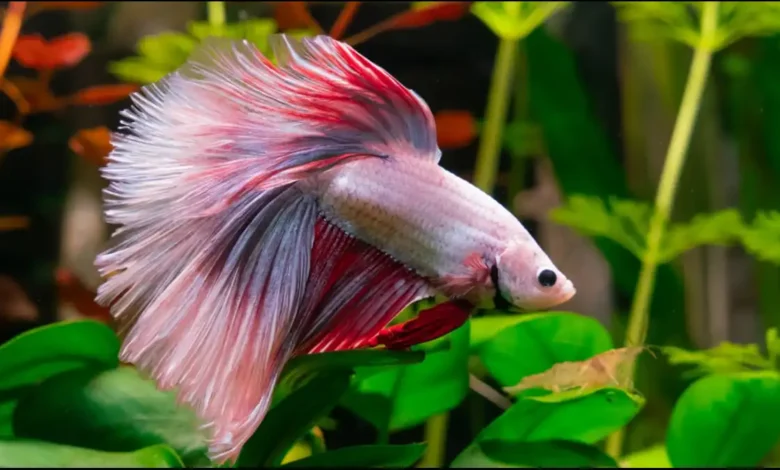Health and Happiness: How to Keep Your Pink Betta Fish Thriving

Introduction to Betta Fish
Pink Betta Fish Welcome to the enchanting world of Betta fish, where vibrant colors and graceful movements captivate every observer.
Among these aquatic beauties, the pink Betta fish stands out with its delicate hues and charming personality.
These stunning creatures add a splash of color to your home and bring joy and tranquility into your life.
But owning a pink Betta is more than just enjoying its beauty; it’s about ensuring their well-being. Health and happiness go hand in hand when caring for your friend.
Understanding their needs can create an environment that fosters physical health and emotional satisfaction.
Let’s dive deeper into how to keep your pink Betta fish thriving!
The Importance of Health and Happiness for Betta Fish
Maintaining the health and happiness of your pink betta fish is vital for its overall well-being.
A thriving betta exhibits vibrant colors, active behavior, and an engaging personality. When these fish are healthy, they can live longer and display their full beauty.
Stress significantly impacts a betta’s health.
Poor water quality or inadequate tank size can lead to anxiety, making them vulnerable to illness.
Happy bettas are more resilient and less likely to suffer from diseases.
Moreover, a contented fish will explore its environment with enthusiasm.
Observing this playful behavior is rewarding and indicates that you provide proper care.
Creating a nurturing habitat fosters emotional well-being in your pink betta fish.
Remember, when your pet feels safe and secure, it reflects positively on all aspects of its life—from physical health to behavioral traits.
Creating the Right Environment for Your Pink Betta Fish
Creating an ideal habitat for your pink betta fish is essential for its well-being.
Start with a spacious tank, ideally at least 5 gallons, which allows ample room for the fish to swim and explore.
Temperature plays a crucial role. Betta fish thrive in warm water, between 76°F and 82°F. A reliable heater can help maintain this cozy environment.
Adding plants provides hiding spots and stimulation. Live or silk plants are great options that mimic their natural habitat without sharp edges.
Ensure the filtration system is gentle enough not to create strong currents; bettas prefer calm waters.
Check water parameters like pH (around 6.5-7) and ammonia levels regularly to keep your pink Betta healthy.
Regular water changes also provide a clean living space that prevents stress-related health issues.
Consider adding decorations like caves or smooth rocks to give them more hiding areas and feel secure.
Nutritional Needs of a Betta Fish
Betta fish, particularly the vibrant pink variety, require a balanced diet. Their nutritional needs revolve around protein-rich foods.
Quality pellets specifically formulated for bettas are essential.
Live or frozen food can be an excellent addition.
Options like brine shrimp and bloodworms provide vital nutrients that keep your fish active and healthy.
It’s important not to overfeed them, which can lead to health issues. A small amount once or twice a day is sufficient.
Include some plant-based options too. Blanched vegetables such as peas or spinach can offer additional fiber and promote digestion.
Always ensure fresh water after feeding to prevent waste buildup in the tank. The right nutrition helps maintain bright colors and energetic behavior in your pink betta fish, enhancing its overall well-being.
Exercise and Mental Stimulation for a Happy Betta Fish
Betta fish are not just pretty faces; they thrive on interaction and stimulation. Providing exercise opportunities can enhance their overall well-being.
Consider adding decorations or plants to the tank.
This creates hiding spots and encourages exploration, making your pink betta fish feel more secure while staying active. Regularly rearranging the layout keeps things fresh for them.
Another engaging option is briefly using mirrors or reflective surfaces.
Betta fish enjoy flaring their fins at what they perceive as rivals, which provides physical activity and mental engagement. Just be careful to limit this exposure to avoid stress.
You might also try floating toys or feeding challenges that require your pink Betta to swim around more actively during meals.
Keeping their environment dynamic sparks curiosity and helps prevent boredom, contributing significantly to a happy aquarium life.
Common Health Issues and How to Prevent Them

Like any pet, pink betta fish can face health challenges.
Early recognition of these issues is key to their well-being.
One common problem is fin rot, which can arise from poor water quality or stress.
Regularly testing your tank’s parameters and maintaining cleanliness can help prevent it.
Another concern is swim bladder disorder, which affects buoyancy
Overfeeding or a sudden diet change often triggers this issue. Stick to a consistent feeding schedule with appropriate portions.
Ich, known as white spot disease, is also prevalent among bettas. It typically occurs in stressed fish due to temperature fluctuations or overcrowded tanks.
Keeping the water stable and ensuring adequate space are essential preventive measures.
Routine observation of your pink Betta’s behavior and appearance will allow you to catch potential problems before they escalate into serious conditions.
Signs of a Happy and Healthy Pink Betta Fish
A happy, healthy pink betta fish displays vibrant colors with fully extended fins. When it swims, it’s energetic and purposeful.
A lively movement around the tank is a great indicator of well-being.
Another sign to watch for is their appetite. A betta that eagerly approaches food shows they’re thriving. Regular feeding without hesitation points to good health.
Look at their fins; if they are smooth and not frayed or clamped against the body, your fish is likely content in its environment.
Engagement with surroundings also matters. If your pink Betta interacts with decorations or plants in the tank, it’s a positive sign of mental stimulation.
Observe how they react when you approach the tank. Their curious behavior indicates comfort in their space and trust in you as their owner.
Conclusion
Caring for your pink betta fish is a rewarding experience that requires attention to their needs.
A healthy, thriving environment can make all the difference in your pet’s life. Remember, creating the right habitat—complete with proper water conditions and plenty of hiding spots—is essential.
Nutrition also plays a pivotal role in their health and happiness. Feed them high-quality pellets or frozen foods designed specifically for bettas to ensure they receive balanced nutrition.
Moreover, incorporating exercise and mental stimulation into their routine will keep them active and engaged. Consider introducing toys or plants to explore within their tank.
Be vigilant about potential health issues such as fin rot or ich. Regular monitoring will help you catch any problems early on.
Being attuned to the signs of happiness in your pink betta fish—like vibrant colors and playful behavior—will guide you in providing optimal care.
With dedication, you can nurture a flourishing relationship with your aquatic companion that brings joy to both of you!





